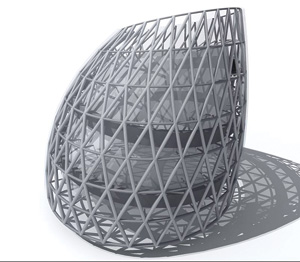It would appear as though Autodesk has pulled off a major acquisition from AEC competitor, Bentley Systems. Dr. Robert Aish, BentleyÝs director of research and ÙfatherÝ of its Generative Components (GC) technology, is set to join AutodeskÝs Building Solutions division this month.
Aish was core to the development and promotion of BentleyÝs parametric form-generating platform, Generative Components, which has been developed on top of MicroStation. Generative Components provides an environment in which geometry (lines, arcs, circles, solids, surfaces) can be given associated relationships, and transformed, generated and manipulated all within a user-defined framework. The product had caused a considerable buzz within the more adventurous architectural design firms, as well as in the structural engineering market – and all while the product was in Beta as it only officially shipped recently.
While the technology was impressive, Aish actually took to the road to promote the technology, assisting in the establishment the Smart Geometry group, which provided training for architectural students and key practice designers who required more complex form-generating solutions.
From my dealings with Bentley there was always some reticence when it came to talk about GCÝs future within the company, as many I talked to didnÝt understand the impact and traction the technology was creating in clients that had advanced geometry problems. GC was seen as a niche technology for one or two signature architects. However, with the subsequent success of Smart Geometry events and larger than expected take up of the early beta, Bentley started to throw more resources behind GCÝs development. In fact, there are buildings and bridges in existence and many going through planning that were developed using these early beta code. AishÝs departure will undoubtedly come as a major blow, perhaps not in the technologyÝs development, but certainly in the technologyÝs promotion.
Autodesk is a company that concentrates on selling volume products. Under relatively new CEO, Carl Bass, the company is expanding to target Signature architects and high-end industries like Automotive design. However, these are very much low-volume industries. The potential of what Aish had done at Bentley was not lost on Bass. At Autodesk University 2006 there was one customer presentation that included the use of Generative Components in finding a solution to designing a complex bridge structure and Autodesk employees were starting to come to Smart Geometry events to see what was going on. Then just after Christmas 2006, Bass emailed me to say that he had learnt how to use Generative Components and from experimentation thought the software was ÙdelightfulÝ. Perhaps then, the seed was sown that Autodesk would attempt to recruit Aish or develop something similar.
Aish is widely respected in the construction industry from years of developing innovative CAD systems and has an enviable set of contacts in all the leading architectural and construction firms. ItÝs certain that anything he would develop at Autodesk, would be eagerly anticipated and tested by AutodeskÝs key target firms.
From talking to Aish, there is no doubt about the passion that he has for generative design, where the computer is the true amplifier of the mind, instead of a mere documentation device. A move to Autodesk would give him the possibility of spreading his technology to millions of designers, in a number of possible applications – AutoCAD, Revit, 3D Studio, Maya or even Inventor. At Autodesk University in Las Vegas in November last year, I talked with Jay Bhatt, VP of AutodeskÝs Building Solutions Division on the subject of what Robert Aish will do for Autodesk. Bhatt was sure that Aish wouldnÝt be copying the work that he did at Bentley and making GC for AutoCAD. Future development plans seemed to be very much in the air, with Aish only just having officially joined Autodesk but they do know that he has significant respect within most of the major architectural practices and thereÝs a bunch of very popular applications that he can now choose to develop on top of. Having had many attempts to develop GC at Bentley (the MicroStation platform kept changing), I would hazard a guess that Aish has not given up on what he has been working on for decades. I am sure he will develop some kind of generative technology for Autodesk, although the target platform is as yet undecided. One only has to look at the latest release of McNeelÝs Rhino to see that form generation is becoming mainstream and Autodesk is aware that it needs to develop that capability. Bentley meanwhile has a head start and will need to develop GC at an accelerated pace to get wider adoption and fend off any future threat from what will be a well financed and accelerated Autodesk development.
In fact, Autodesk and Bentley appear to be on collision courses in more than one vertical, now that Autodesk has expanded into developing vertical applications for Geo, Civil Engineering, Power and Process Plant. Autodesk has reverse engineered its own DGN (MicroStation) file format and appears to be recruiting aggressively from BentleyÝs various vertical sales and product management teams. While in the past Autodesk has appeared a less aggressive industry giant, playing more of a defensive role, the companyÝs recent product expansion and outstanding revenue performance, comes with a new competitive attitude and strategies to single out Dassault Systemes in the engineering space and Bentley in the building and infrastructure for focus. The bottom line of all this development activity and increased competition is that the designer is going to get better, smarter tools, more choice and competitive deals, either being an existing or new customer.
www.bentley.com
www.autodesk.com
www.smartgeometry.com






